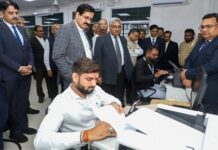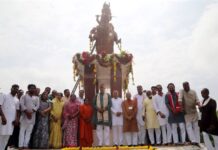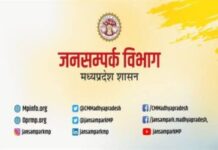It has to be stated without mincing any words that the Andhra Pradesh High Court at Amaravati in a most learned, laudable, landmark, logical and latest judgment titled Gokeda Pydithalli (A-1) & 2 Others and Others Vs. State Of A P in Criminal Appeal No. 380/2009 and Criminal Revision Case No. 733 of 2010 and cited in Neutral Citation No.: APHC010113412009 in the exercise of its special original jurisdiction that was pronounced as recently as on 22 April, 2024 has reiterated the paramount importance of conducting joint trials for case and counter case to ensure a fair judicial process. We need to note here that the Bench underscored the need for both case and counter case to be tried simultaneously by the same court to avoid conflicting judgments. It was stated most unequivocally by the Court that, “The necessity to try case and counter case together is so eminent. Otherwise it is likely to give rise to disastrous results.” There can be thus definitely no gainsaying that this cardinal principle that was so clearly underscored by the court ensures that both sides of the dispute receive equal treatment and opportunities for defense. No denying it.
At the very outset, this brief, brilliant, bold and balanced judgment authored by Hon’ble Mr Justice BVLN Chakravarthi for a Division Bench of the Andhra Pradesh High Court comprising of Hon’ble Mr Justice K. Suresh Reddy and himself sets the ball in motion by first and foremost putting forth in para 1 that, “The appeal assails the judgment dated 31.03.2009 passed by the learned II Additional District and Sessions Judge (Fast Track Court), Vizianagaram at Parvathipuram in Sessions Case No. 71 of 2005. During the pendency of the appeal, A-2 died on 07.05.2021 and as such, appeal filed for the A-2 has abated vide this Court’s order dated 06.10.2023.”
To put things in perspective, the Division Bench then envisages in para 2 that, “The accused No.1 and 2 were tried for the offence U/s.302 of Indian Penal Code, 1860 (hereinafter referred to as (‘I.P.C.’) for causing the death of one Smt Senapathi Demudamma (hereinafter referred to as deceased) on 12.10.2004 at about 09.00 p.m. in Veeluparthi Village, near the house of Senapathi Tata (P.W-1). The accused A-3 along with A-4 were tried for the offence U/s.302 r/w.34 of I.P.C. for causing death of Smt.S.Demudamma. A-1 was also tried for the offence U/s.324 I.P.C. for voluntarily causing simple hurt to Gokeda Somulamma (P.W-4) on or about the same day, time and place mentioned above. A-2 and A-3 along with A-4 were tried for the offence under U/s.324 r/w.34 of I.P.C. for voluntarily causing simple hurt to Smt.G.Somulamma (P.W-4) on or about the same day, time and place mentioned above. A-1 and A-2 were further tried for the offence U/s.323 I.P.C. for voluntarily causing hurt to S. Tata (P.W-1), S.Chellam Naidu (P.W-2), S.Appala Ramana (P.W-3), G.Satyanarayana (P.W-5) and G.Kannayya (P.W-6) on or about the same day, time and place mentioned above. A-3 along with A-4 were further tried for the offence U/s.323 r/w.34 I.P.C. for voluntarily causing hurt to the above persons on the same day, time and place mentioned above.”
As it turned out, the Division Bench then enunciates in para 3 that, “The learned II Additional District & Sessions Judge (Fast Track Court), Vizianagaram at Parvathipuram, vide judgment dated 31.03.2009 convicted A-1 and A-2 for the offence U/s.304-I, 324 and 323 r/w.34 of I.P.C., A-3 was convicted for the offence U/s.324 and 323 of I.P.C. Accordingly, sentenced A-1 and A-2 to undergo rigorous imprisonment for 10 years each, and also to pay fine of Rs.1,000/- each, in default of payment of fine, to undergo simple imprisonment for a period of six (06) months each for the offence U/s.304-I I.P.C; Sentenced A-1 to undergo rigorous imprisonment for a period of two years and also to pay fine of Rs.500/-, in default of payment of fine, to undergo simple imprisonment for a period of three (03) months for the offence U/s.324 I.P.C.; Sentenced A-1 to undergo simple imprisonment for a period of three months and also to pay fine of Rs.100/-, in default of payment of fine, to undergo simple imprisonment for a period of 15 days for the offence U/s.323 I.P.C.”
As we see, the Division Bench discloses in para 4 that, “The learned II Addl. District & Sessions Judge (Fast Track Court), Vizianagaram at Parvathipuram, convicted and sentenced A-2 to undergo rigorous imprisonment for a period of two years and also to pay fine of Rs.500/-, in default of payment of fine, to undergo simple imprisonment for a period of three (03) months for the offence U/s.324 I.P.C; Further convicted and sentenced A-3 to undergo rigorous imprisonment for a period of two years and also to pay fine of Rs.500/-, in default of payment of fine, to undergo simple imprisonment for a period of three (03) months for the offence U/s.324I.P.C.; Also sentenced A-3 to undergo simple imprisonment for a period of three months and also to pay fine of Rs.100/-, in default of payment of fine, to undergo simple imprisonment for a period of 15 days for the offence U/s.323 I.P.C; The learned II Addl. District & Sessions Judge (Fast Track Court), Vizianagaram at Parvathipuram, acquitted A-4 on all charges. Challenging the said conviction and sentence, the accused No.1 to 3 filed the present appeal U/s.374(2) of Code of Criminal Procedure, 1973 (hereinafter referred to as ‘Cr.P.C.’).”
Most significantly, the Division Bench mandates in para 31 propounding that, “The Division Bench of High Court of Andhra Pradesh in the case of State of A.P. Vs. Mittapalli Sudhakara Reddy and others referred the case of Nathi Lal Vs. State of U.P., of the Hon’ble Apex Court on the principles dealing with the issue relating to the case and cross case. The fair procedure to adopt in a case and counter case, is to direct that the same Judge must try both the cross cases one after the other. After recording of the evidence in one case is completed, he must hear the arguments, but he must reserve the judgment. Thereafter, he must proceed to hear the cross case and after recording all the evidence, he must hear the arguments, but reserve the judgment in that case. The same Judge must thereafter dispose of the matters by two separate judgments. In deciding each of the cases, he can rely only on the evidence recorded in that particular case. The evidence recorded in the cross case cannot be looked into. Nor can the judge be influenced by whatever is argued in the cross case. Each case must be decided on the basis of the evidence, which has been placed on record in that particular case without being influenced in any manner by the evidence or arguments urged in the cross case. But both the judgments must be pronounced by the same Judge one after the other.”
Do note, the Division Bench notes in para 32 that, “In the case on hand, it is regrettable that the learned Sessions Judge failed to notice the two important circumstances i.e., change of scene of offence, at a later point in time with an intention to avoid independent witnesses. Failure of the prosecution agency to take steps for trial and disposal of case and counter case by the same Judge, for the reasons known best to it.”
Be it noted, the Division Bench then notes in para 33 that, “The necessity to try case and counter case together is so eminent. Otherwise it is likely to give rise to disastrous results. From the judgment of the High Court of Andhra Pradesh referred above, it is clear that in a case and counter case, both the cases should be tried together by same Court irrespective of nature of offence involved and they should be tried simultaneously one after the other. The learned Public Prosecutor in one case shall not act as a Public Prosecutor in the counter case. The evidence in one case cannot be looked into in the counter case, and judgment in both the cases shall be pronounced on the same day. The rationale behind this is to avoid conflicting judgments, which may lead to disastrous results at times.”
It is worth noting that the Division Bench notes in para 37 that, “In the case on hand, the prosecution did not explain the injuries sustained by the accused at the time of occurrence or in the course of altercation. P.Ws-1 to 6 made an attempt to suppress the injuries sustained by the accused in the same incident. Therefore, we are of the opinion that an inference can be drawn that the prosecution suppressed the genesis and origin of the occurrence, and thus not presented the true version. The prosecution witnesses are lying on many material points. The above facts creating a reasonable doubt that they suppressed the truth about the genesis of the incident, and came with a coloured version to implicate all the family members of the accused No.1.”
While citing the most relevant and remarkable case laws, the Bench hastens to add in para 38 stating that, “The Hon’ble Apex Court in the case of Vadivelu Thevar Vs. State of Madras 1957 AIR SC 614; Khema @ Khem Chandra Etc.,Vs. State of Uttar Pradesh; Parshuram Vs. State of M.P.2023 SCC Online SC 1416 and Nand Lal and Others Vs. The State of Chhattisgarh held that it is sound and well established rule of law that the Court is concerned with the quality and not with the quantity of the evidence necessary for proving or disproving a fact. Generally speaking, oral testimony in this context may be classified into three categories i.e., (1) wholly reliable, (2) wholly unreliable, and (3) Neither wholly reliable nor wholly unreliable.”
Quite significantly, the Division Bench points out in para 39 that, “Undisputedly, in the present case, P.Ws-1 to 6 are the injured witnesses. Their presence cannot be disputed. However, as already observed hereinabove, there was a previous enmity between the prosecution party and the accused party on account of the issues between P.W-3 and his wife, who is daughter of A-1. Therefore, a possibility of false implication cannot be ruled out. The accused No.1 and his three brothers were roped in. The evidence of P.W-14/Investigation Officer would show that his investigation disclosed that A-4 was not present at the time of incident. The learned Sessions Judge basing on the said evidence, acquitted A-4. As already discussed above, it is established that the scene of offence was shifted to thrashing floor from the house of P.W-1, to avoid independent witnesses, though several people witnessed the incident. The evidence came on record would disclose that both parties quarrelled and beat each other.”
No less significant is what is then laid bare by the Division Bench in para 41 that, “As already discussed hereinabove, P.W-7 did not support the case of the prosecution. The independent witnesses cited by the prosecution were not examined without any valid reason. Taking into account the above circumstances, we are of the opinion that possibility of accused being falsely implicated cannot be ruled out. In our view, the conviction of accused purely on the basis of oral testimony of P.W-1 to P.W-6, without sufficient corroboration, would not be safe. We are therefore, of the considered view that the appellants/A-1 and A-3 are entitled to benefit of doubt.”
Finally, the Division Bench concludes by holding in para 42 that, “In the result, the Criminal Appeal No.380/2009 is allowed. The conviction and sentence recorded by the learned II Addl. District & Sessions Judge (Fast Track Court), Vizianagaram at Parvathipuram, vide judgment dated 31.03.2009 in S.C.71/2005 against the appellants/A-1 and A-3 for the offence U/s.304-I, 324 and 323 I.P.C. is set aside. A-1 and A-3 are acquitted U/s.235(1) Cr.P.C. The fine amount, if any, paid by the appellants/A-1 and A-3 shall be refunded to them. The bail bonds of A-1 and A-3 shall stand cancelled. Consequently, the Crl.R.C.No.733/2010 shall stand dismissed. As a sequel, miscellaneous petitions, pending, if any, in the Criminal Appeal and Criminal Revision Case shall stand closed.”
All told, we thus see that the Andhra Pradesh High Court has made it indubitably clear in this leading judgment that fair trial in criminal cases involving cross-complaints necessitates both cases be tried together by the same Judge to avoid prejudice. It thus merits no reiteration that all Judges and all courts must pay heed to what the Andhra Pradesh High Court has held in this notable case and act accordingly in similar such cases. No denying it!
Sanjeev Sirohi, Advocate,
s/o Col (Retd) BPS Sirohi,
A 82, Defence Enclave,
Sardhana Road, Kankerkhera,
Meerut – 250001, Uttar Pradesh.
Disclaimer
The information contained in this website is for general information purposes only. The information is provided by TodayIndia.news and while we endeavour to keep the information up to date and correct, we make no representations or warranties of any kind, express or implied, about the completeness, accuracy, reliability, suitability or availability with respect to the website or the information, products, services, or related graphics contained on the website for any purpose. Any reliance you place on such information is therefore strictly at your own risk.
In no event will we be liable for any loss or damage including without limitation, indirect or consequential loss or damage, or any loss or damage whatsoever arising from loss of data or profits arising out of, or in connection with, the use of this website.
Through this website you are able to link to other websites which are not under the control of TodayIndia.news We have no control over the nature, content and availability of those sites. The inclusion of any links does not necessarily imply a recommendation or endorse the views expressed within them.
Every effort is made to keep the website up and running smoothly. However, TodayIndia.news takes no responsibility for, and will not be liable for, the website being temporarily unavailable due to technical issues beyond our control.
For any legal details or query please visit original source link given with news or click on Go to Source.
Our translation service aims to offer the most accurate translation possible and we rarely experience any issues with news post. However, as the translation is carried out by third part tool there is a possibility for error to cause the occasional inaccuracy. We therefore require you to accept this disclaimer before confirming any translation news with us.
If you are not willing to accept this disclaimer then we recommend reading news post in its original language.













